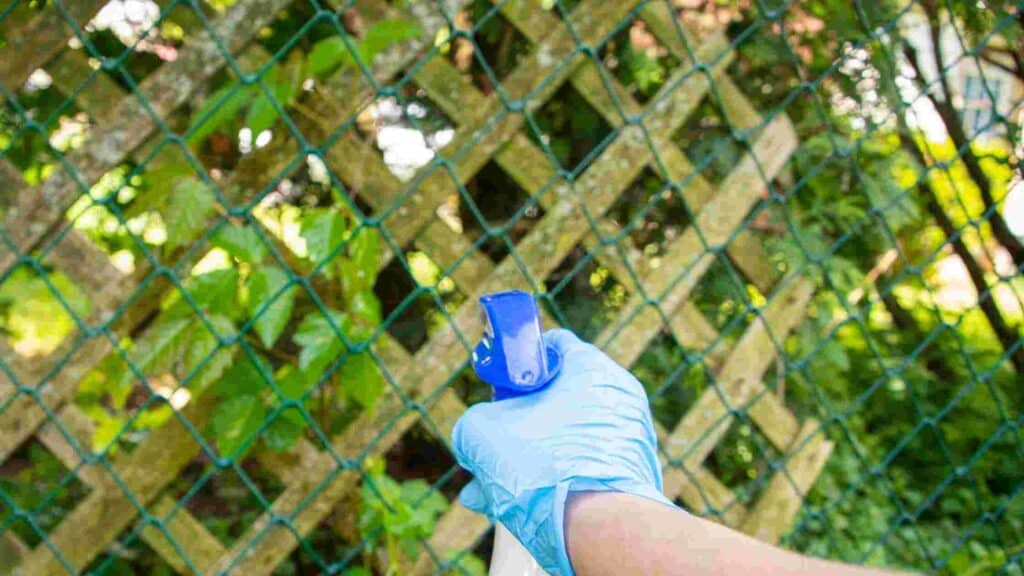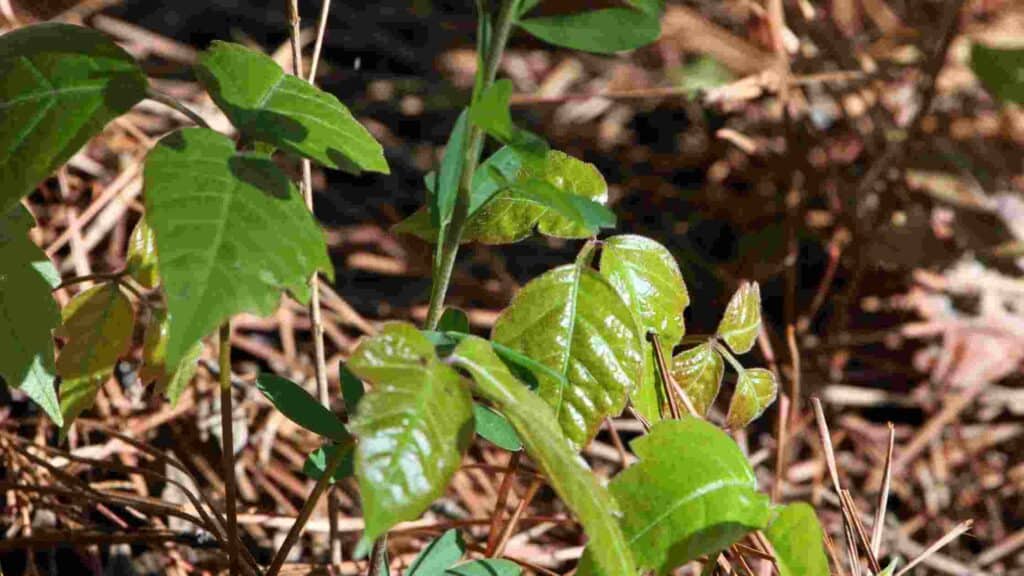So, you’ve got a poison ivy problem in your outdoor garden? Don’t worry; we’ve got your back! In this article, we’ll show you how to get rid of poison ivy in the yard.
Dealing with that itchy, bumpy, and allergic plant can be really difficult.
How To Get Rid Of Poison Ivy In The Yard
1. Use Organic Herbicides
Now, if you prefer a more eco-friendly approach, consider using an organic herbicide.
These natural solutions may require a bit more attention and a few extra rounds of application, but they’re pet and family safe (when used as directed, of course). Plus, you won’t have to worry about those cancer controversies like some other commercial herbicides.
Check out our top pick for the best weed killer for lawns.
2. DIY Poison Ivy Killer – Killing Poison Ivy with Vinegar

Here’s a recipe for a DIY poison ivy killer, straight from your kitchen cabinet:
- 1 cup of salt
- 3 cups of vinegar
- 1 tablespoon of dish soap
Mix that salt into the vinegar until it’s all dissolved, then add that splash of dish soap and stir it up (if you are curious about Epsom salt, check out: does Epsom salt kill weeds?).
Now, grab a spray bottle and begin the work! Coat those leaves, stems, and roots with your homemade solution – but be careful, it doesn’t discriminate, so spare the plants you want to keep.
Wait up to a week before reapplying or taking down any new ivy invaders (find out: how long does it take for salt to kill weeds?).
3. Pulling The Plants Out By The Roots
If you want to take down poison ivy, grab those garden gloves, preferably the long, protective ones, and start pulling that plant out by the roots.
The key here is to make sure no piece of the root is left behind. Otherwise, it’s like going to come back again. So be thorough, and don’t hold back!
4. Use A Plywood Sheet
Using a sheet of plywood is a simple yet effective method to get rid of that poison ivy. Grab a thick sheet of plywood and lay it right on top of the plant.
Secure it in place with some heavy rocks – we don’t want it getting away (learn what to put under rocks to prevent weeds). This move will block out any sunlight from reaching the ivy, effectively smothering it and causing it to wither away.
Be careful, though; those roots might try to make an escape and grow elsewhere in your yard. Keep an eye out and be ready to spring into action!
Now, before you go out and grab any old plywood, make sure you’re using the good stuff! Premium Baltic Birch Plywood is a great option for maximum effectiveness.
5. Using Boiling Water – How To Get Rid Of Poison Ivy Plants Naturally
For a quick poison ivy fix, boiling water does the trick. This one’s perfect for those plants lurking around sidewalks or buildings.
Boiling water can take down any grass or other plants nearby too (here’s how to kill grass and weeds). Just grab a pot of boiling water and pour it on that poison ivy.
Before you do that, consider slightly exposing the roots by giving them a gentle dig. Then, pour that water! Remember to dig up those roots afterward.
How To Stop Poison Ivy From Growing Back

Now that you’ve gotten rid of that poison ivy, let’s talk about keeping it at bay in the future. Here are a couple of options.
Option 1: Lawn Maintenance
You can take charge and keep that poison ivy in check with some lawn maintenance.
- Watering Advice: Water your lawn well, and your grass will secure its roots deep into the soil, ready to take on weeds and poison ivy (here’s how to fix a lawn full of weeds). Avoid watering lightly and frequently, as that will only give your lawn shallow roots, making it easier for those plants to take over.
- Height Matters: When mowing your grass, resist the urge to go super short. Let your grass stand tall, cutting it with one of the two higher settings on your lawnmower. This will keep the competition for sunlight high, choking out any common weeds and poison ivy plants.
- Feed Your Lawn: Treat your lawn to some lawn food every 6 to 8 weeks. This will keep it strong, thick, and healthy, giving those weeds no chance to take root and mature. Our top pick is the Simple Lawn Solutions Natural Liquid Fertilizer.
Option 2: Unconventional Grazers
If you happen to have a sheep, goat, or cow lounging around your property, consider yourself lucky. These animals love snacking on poison ivy.
And guess what? It won’t harm these animals! A win-win situation for everyone – your pets get a treat, and you get a yard free from itchy ivy.
Preventing Poison Ivy Rash
Of course, the best way is to avoid getting that poison ivy on your skin in the first place.
To protect yourself, gear up – wear gloves, long pants, and long sleeves when working in the garden. And remember, no touching your eyes or rubbing your face with gloved hands!
How To Treat A Poison Ivy Rash
Alright, you’ve done your best to take down that poison ivy, but it seems like the plant has given you a red, itchy rash!
Here are some tips to soothe that rash and get you back to enjoying the outdoors.
Spotting The Poison Ivy Rash

First things first, let’s make sure we’re dealing with the right problem, and that rash is from dealing with poison ivy.
Look for some telltale signs. A poison ivy rash will appear as long streaks or clusters of raised, red, and itchy blisters. You’ll probably notice it popping up 1 or 2 days after working on poison ivy.
Tecnu Extreme Poison Ivy And Oak Scrub
When it comes to battling the itch from a poison ivy rash, the Tecnu Extreme Poison Ivy and Oak Scrub is a great choice! It works by removing those plant oils from your skin that cause all the itching and rash spreading.
Just one use of this scrub, and you’ll be able to enjoy up to 24 hours of itch relief. You can even use it proactively, say after spending some quality time in the garden, to prevent the rash from happening.
When To Get Medical Help
Now that you’ve armed yourself with some DIY poison ivy remedies, let’s talk about when to seek some expert help. Most times, that itchy rash is just an annoyance that’ll go away on its own, but in some cases, it can get serious.
The following situations call for some professional backup:
- When the rash shows no signs of improvement after a whole week.
- If the rash starts getting too close to your mouth or eyes or gets into intimate parts of your body.
- When that rash spreads across a large portion of your body, like taking over most of your arm, leg, or torso.
- If the rash is leaking pus or sporting yellow scabs.
Certain signs require immediate action – call the doc ASAP if you experience any of these:
- Swelling in the mouth, throat, or eyes causes difficulty in swallowing or seeing.
- Difficulty breathing. It’s a serious matter that needs prompt attention.
- Fever.
These signs demand quick medical attention, and you might need topical and oral treatment to get better.
Home Remedies – How To Get Rid Of Poison Ivy Rash Overnight
Here are a few home remedies that might do the trick:
- Avoid Scratching: As tempting as it may be, resist the urge to scratch that rash. If there’s any poison ivy oil lingering under your nails, scratching will only spread the rash and can lead to infections.
- Rubbing Alcohol: Alcohol can wipe away the poison ivy oils from your skin. To get the most out of it, use rubbing alcohol on the affected area within the first 10 or 15 minutes of exposure to poison ivy. Then, hop in a hot shower and wash it all away with regular soap to get rid of any excess oil.
- Use a Cold Compress: The cold can fight against itching and inflammation. Grab a clean rag, soak it in cold water, or wrap some ice in it. Then, apply it directly to the poison ivy rash for 15 to 30 minutes. Repeat this as often as needed throughout the day.
FAQs
1. What kills poison ivy permanently?
Persistent removal methods like digging out the roots or using herbicides specifically designed for poison ivy can kill it permanently.
2. How do you kill poison ivy but not grass?
To kill poison ivy without harming the grass, spot-treat the poison ivy leaves with a suitable herbicide, being careful not to overspray onto the grass.
3. Will vinegar kill poison ivy permanently?
While vinegar may kill some parts of poison ivy temporarily, it may not eliminate the roots entirely, so it might not be a permanent solution.
4. How to get rid of poison ivy without killing other plants?
To remove poison ivy without harming other plants, manually uproot it, ensure to wear protective clothing, or use targeted herbicides.
5. How to get rid of poison ivy in one day?
Completely eliminating poison ivy in one day is unlikely; it usually requires repeated treatments and careful removal.
6. What is the best time to kill poison ivy?
The best time to kill poison ivy is during its active growing season in late spring to early fall when it’s most susceptible to herbicides.
7. Do you recommend killing poison ivy with Clorox?
Using bleach (Clorox) to kill poison ivy is not recommended, as it can harm the environment and surrounding plants.
Conclusion – How To Get Rid Of Poison Ivy In Your Backyard
Alright, now that you’ve got all the poison ivy knowledge at your fingertips, it’s time to take action!
Herbicides, pouring boiling water, pulling up those plants, strengthening your lawn – these are your options to remove and prevent those annoying garden invaders (you may also be interested in checking out how to keep weeds out of flower beds)
Remember, prevention is the best defense! To remove those plant oils from your body, wash your skin with rubbing alcohol and then take a shower immediately after any potential exposure. That’ll keep the rash at bay.
If you find yourself stuck with that itchy rash, you can try over-the-counter treatments and home remedies. The Tecnu Extreme Poison Ivy and Oak Scrub can help by providing itch relief for up to 24 hours. And if you need a quick fix, home remedies like rubbing alcohol or a cold compress can be useful in fighting against the itch.
Armed with wisdom and caution, you can conquer that poison ivy and turn your garden into a haven of green delight.
